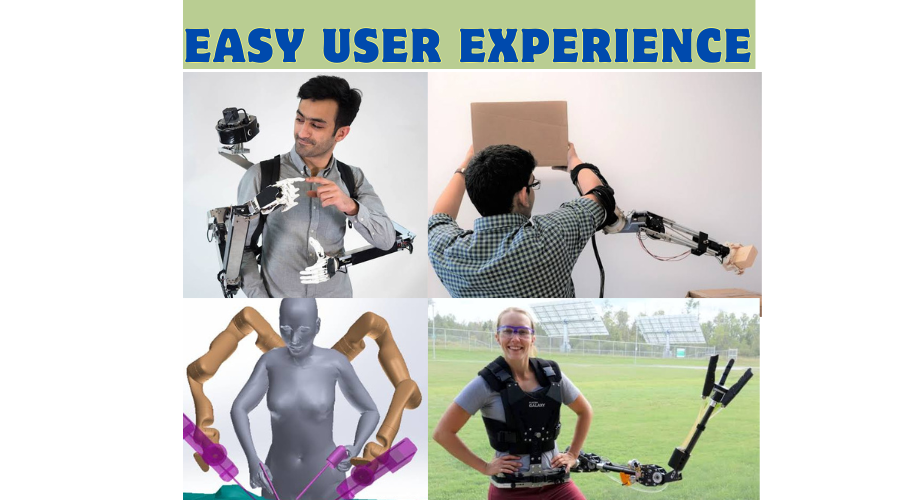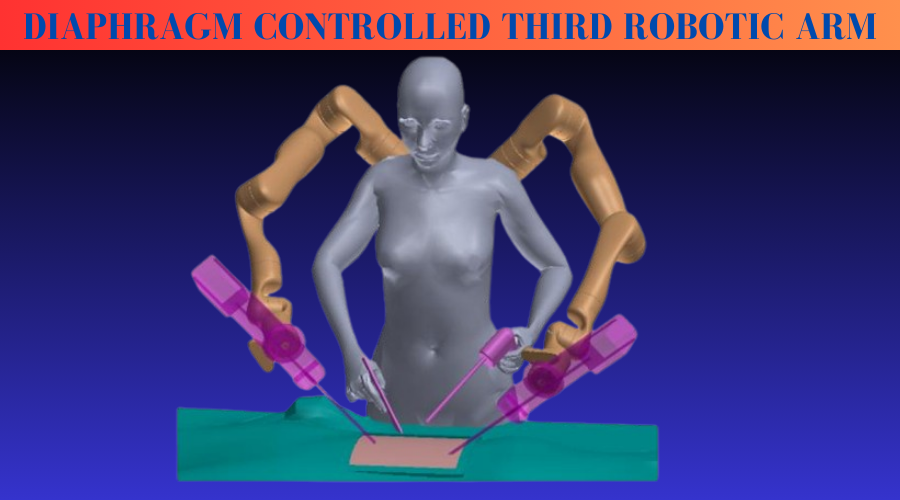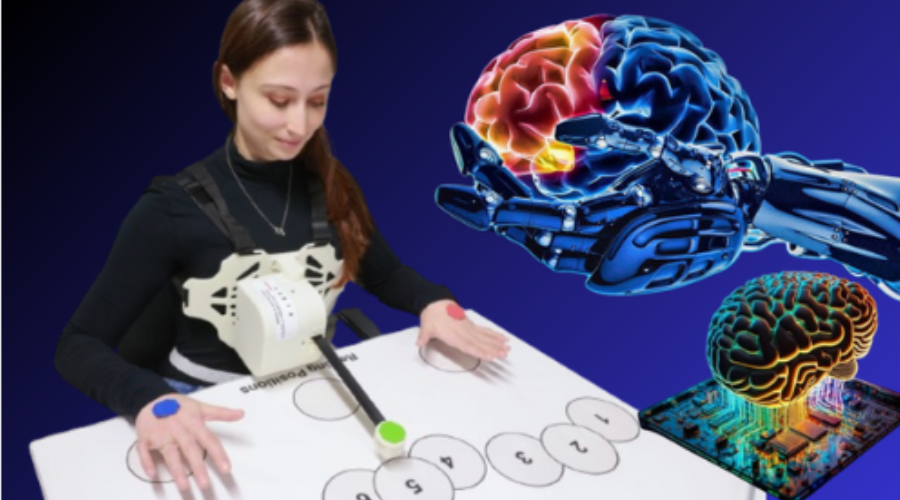Introduction:
In a significant leap towards expanding the capabilities of the human body, neuroengineers at Ecole Polytechnique Federale de Lausanne (EPFL) have successfully developed and tested a robotic third arm controlled by the diaphragm. This innovative technology not only holds promise for augmenting healthy human bodies but also offers unique insights into the intricate relationship between the nervous system and the brain in controlling limbs.
Breathe Easy, Control a Third Arm: Scientists Make Futuristic Tech Surprisingly Accessible
Imagine having an extra arm, seamlessly integrated and controlled by your own breath. This might sound like science fiction, but thanks to a team of brilliant scientists at the École Polytechnique Fédérale de Lausanne (EPFL), it’s a giant leap closer to reality.
Their groundbreaking research, published in Science Robotics, details the development and successful testing of a robotic third arm controlled by the diaphragm muscle. This means you could potentially manipulate objects, operate tools, or even express yourself in entirely new ways, all through the subtle power of your breath.
Robotic Third Arm: Potential Applications and Challenges


| Application | Description | Benefits | Challenges |
|---|---|---|---|
| Surgery | Surgeons control multiple instruments with breath-controlled precision. | Enhanced dexterity, improved patient outcomes, reduced surgeon fatigue. | Integrating technology into sterile environments, ensuring instrument safety and responsiveness. |
| Manufacturing & Assembly | Workers manipulate delicate components or operate heavy machinery with an extra limb. | Increased efficiency, reduced risk of injury, enhanced productivity. | Designing ergonomic and safe interfaces for human-robot interaction, adapting to diverse workplaces. |
| Accessibility | People with limited mobility regain independence and perform daily tasks. | Improved quality of life, increased autonomy, restored ability to complete daily activities. | Developing intuitive control interfaces for individuals with varying degrees of mobility, ensuring device affordability and accessibility. |
| Artistic Expression | Dancers, musicians, and artists utilize the third arm for creative expression. | New forms of art, enhanced performance capabilities, groundbreaking artistic possibilities. | Integrating the third arm seamlessly into artistic disciplines, overcoming limitations in dexterity and control for creative expression. |
Easy User Experience


User-Friendly Design
One of the standout features of the robotic third arm is its user-friendly design. Engineers have prioritized simplicity without compromising functionality, ensuring that users, regardless of technical expertise, can seamlessly integrate the robotic limb into their daily activities.
Training Process for Users
To further enhance the user experience, scientists have developed an efficient training process. Users quickly adapt to the breath-controlled system, highlighting the system’s intuitiveness and ease of use.
Real-World Applications and Examples
The real-world applications of this technology are vast and varied. From assisting individuals with limited mobility to enhancing productivity in industries requiring precise movements, the breath-controlled third arm proves its versatility.
The Diaphragm-Controlled Robotic Third Arm:


The recent study, published in the journal Science Robotics, details the success of the team’s efforts in creating a diaphragm-controlled robotic third arm. Users can adapt and learn to control this extra limb, emphasizing the importance of thoughtful human-machine interfaces to ensure enhanced capabilities complement existing abilities seamlessly.
Experiment and Results:
- Volunteers participated in virtual reality experiments.
- A real exoskeleton controlled digital right and left arms.
- Diaphragm-controlled third arm appeared symmetrical and was managed through a diaphragm belt.
- Control method did not interfere with natural breathing or speaking.
Challenges and Solutions:
Implementing control strategies that do not hinder natural abilities was a major challenge, but the researchers successfully addressed it. The diaphragm belt, measuring the diaphragm’s movements, enabled users to control the robotic arm without compromising their essential physiological functions.
Potential Applications:
While the concept of a third arm may evoke thoughts of everyday convenience, the researchers emphasize the broader potential applications, especially in high-risk scenarios such as search and rescue operations. The ability to control a wearable extra robotic arm could prove more effective and safer than coordinating multiple rescuers, showcasing the life-saving potential of this technology.
Testing the Future, One Breath at a Time


As the team plans to explore real-world use cases and different environments, the future iterations of the robotic third arm hold exciting possibilities. The ongoing research aims to refine the technology for various applications, paving the way for a future where humans can seamlessly integrate additional robotic limbs into their daily lives.
The researchers recruited 65 brave volunteers to test this innovative technology. They used a combination of virtual reality (VR) and real-world robotic arms. In the VR world, participants controlled digital arms with their hands, while the real third arm, appearing as a virtual hand on their chest, responded to their diaphragm movements measured by a special belt.
The results were nothing short of astounding. Participants quickly learned to control the third arm with surprising dexterity, performing tasks like picking up objects, moving them around, and even playing simple VR games. Importantly, this breathing-based control didn’t interfere with their natural breathing or speech, a major hurdle successfully overcome by the team.
Embracing the Possibilities
While the technology is still in its early stages, the successful testing marks a significant milestone. Researchers are now focusing on refining the control system, miniaturizing the hardware, and ensuring its long-term comfort and safety for users.
Of course, ethical considerations come into play with such groundbreaking advancements. Concerns about privacy, data collection, and potential misuse of the technology need to be addressed carefully and transparently.
By embracing responsible development and open dialogue, we can ensure that this breath-controlled third arm becomes a tool for good, empowering individuals and shaping a future where human-machine interaction reaches unprecedented levels of intuitiveness and possibility.
So, the next time you take a deep breath, remember that it might not just be filling your lungs, but also powering the future of human-machine interaction. And who knows, maybe one day, we’ll all be sporting that extra arm, seamlessly controlled by the rhythm of our own breath.
Comparison with Traditional Robotic Systems


Advantages and Disadvantages of Breath-Controlled vs. Traditional Control Systems for Robots
| Feature | Breath-Controlled System | Traditional Control System |
|---|---|---|
| Interaction | Intuitive and natural | Requires learning and technical expertise |
| Learning Curve | Minimal | Steep |
| Precision | Enhanced for controlled movements | Variable depending on control type and user skill |
| Application Suitability | Limited for rapid and complex tasks | Versatile, suitable for diverse tasks |
| Reliability | Emerging technology, less established record | Proven track record and robust framework |
| Customization | Limited options for complex commands | High degree of customization and command complexity possible |
| User Experience | More intuitive and accessible | Less intuitive, may require training |
FAQs: Robotic Third Arm Controlled by Breathing
What is the Robotic Third Arm controlled by breathing?
The Robotic Third Arm is a novel device developed by scientists that can be controlled through a user’s breathing patterns. It serves as an additional appendage to aid in various tasks and activities.
How does the Robotic Third Arm work?
The robotic arm is designed to respond to the user’s breath control. By employing a system that interprets specific breathing patterns, users can manipulate the arm’s movements, allowing for intuitive and hands-free operation.
Who developed the Robotic Third Arm?
The robotic arm is a result of collaborative efforts by a group of scientists. The development team includes experts in robotics, biomechanics, and engineering.
What are the applications of the Robotic Third Arm?
The applications are diverse, ranging from assisting individuals with physical disabilities in daily tasks to enhancing productivity in professional settings. The robotic arm can potentially be used in industries, healthcare, and personal assistance.
How easy is it to learn and use the Robotic Third Arm?
The device is surprisingly easy to use. Users typically adapt quickly to the control mechanism based on breathing patterns. Training requirements are minimal, making it accessible for a broad range of users.
Is the Robotic Third Arm safe to use?
Yes, the safety of the users is a top priority in the development of the Robotic Third Arm. The device is equipped with sensors and safety features to prevent accidents and ensure a secure user experience.
Can anyone use the Robotic Third Arm, or is it specifically designed for certain individuals?
While the primary focus is on assisting individuals with physical disabilities, the Robotic Third Arm is designed to be adaptable for a wide range of users. Its flexibility makes it suitable for various applications and user profiles.
What is the potential impact of the Robotic Third Arm on society?
The impact is substantial, as the device has the potential to improve the quality of life for individuals with physical limitations. Additionally, it may contribute to increased efficiency and productivity in professional environments.
Are there any limitations to the Robotic Third Arm?
Like any technology, the robotic arm has its limitations. It may not be suitable for all tasks, and its effectiveness may depend on the user’s specific needs and capabilities. Ongoing research and development aim to address and overcome these limitations.
Is the Robotic Third Arm available for purchase?
As of now, details regarding the commercial availability of the Robotic Third Arm are not provided. It is advisable to stay updated with the latest announcements from the development team or affiliated institutions for information on potential releases or collaborations.
Conclusion:
The successful development of a diaphragm-controlled robotic third arm marks a significant milestone in the field of neuroengineering. This groundbreaking technology not only expands our understanding of human-machine interaction but also offers potential solutions to challenges in various industries. As researchers continue to refine and explore the capabilities of this innovative robotic augmentation, the prospect of a future where humans can benefit from additional limbs for enhanced performance and safety becomes increasingly tangible.


TotalInfo4U: Your Ultimate Source for Comprehensive Knowledge

